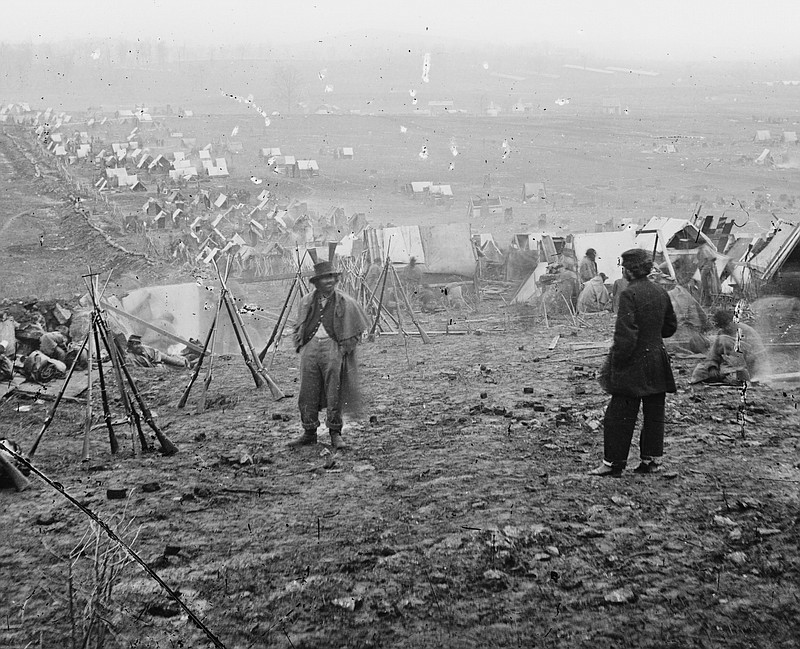Editor's note: This column, about the Battle of Nashville and the actions of the 13th Colored Regiment there, is the first in a series of topics slated to be deleted from the eighth grade Tennessee social studies standards.
It was the South's most desperate battle. It is the South's most forgotten battle.
In December 1864, what was left of the Confederate Army of Tennessee tried to take control of Nashville from the U.S. Army, which had held the city for the previous 2 1/2 years. Outnumbered 3-to-1, half starved, outgunned and, in many cases, without shoes, the Confederates were routed and chased south for the last time.
In places like Shiloh and Fort Donelson, large parts of the battlefield are preserved. But the battlefield of Nashville has been covered over and largely forgotten. Many people who died that day remain buried in unknown places in the Green Hills and Oak Hills parts of town. One can inspect the remains of a Civil War fort, but it wasn't the scene of the major parts of the battle.
It is only through the recent efforts of a few local history buffs that some of the remaining battle sites have even been found.
Here is some background:
In the fall of 1864, Confederate Gen. John Bell Hood left Southern Georgia undefended and marched his army back to Tennessee. On Nov. 30, 1864, his army lost about 7,000 of its 20,000 fighting men at the disastrous assault at the Battle of Franklin.
After the Battle of Franklin, Union Gen. John Schofield (a West Point classmate of Hood's) ordered his men to go back to Nashville. There, his army could rest and be protected by defenses that included a 4-mile trench and several forts. The largest of these forts was a complex structure called Fort Negley -- which guarded Nashville from southern invasion and had been built largely by African-American U.S. Army soldiers.
In spite of their defeat at the Battle of Franklin, Hood ordered his Confederate troops to continue north, to the outskirts of Nashville. Nearly starving by this phase of the war, the Confederates dug entrenchments and lived in them while the weather turned very cold in Nashville.
Finally, on Dec. 15, the Union Army attacked. Unlike at Shiloh, Stones River and Franklin, the Union army attacked first at Nashville. At 8 a.m., on the Union left (the Confederate right), a Union force attacked a Confederate dirt fort called Granbury's Lunette, near the Nashville and Chattanooga Railroad, southeast of town.
The Confederate troops won this initial skirmish. However, Hood didn't realize the attack on the lunette was a diversion meant to hide the fact that the primary Union attack was coming on the opposite end of the battlefield.
As part of this main attack, 8,000 U.S. Army cavalry (soldiers on horseback) and 37,000 U.S. Army infantry (soldiers on foot) rode and marched west, then south, and attacked the small fortresses the Confederates had built in the vicinity of Hillsboro Pike. On the western end of the battlefield, about 6,000 Confederates were up against about 37,000 U.S. Army soldiers.
Today, it is hard to imagine this assault, because the land on which the U.S. Army advanced is now houses, businesses, roads, Interstate 440 and the Belmont and Vanderbilt University campuses. Furthermore, today the land is covered with thousands of trees.
For a while, Confederate soldiers managed to hold off the U.S. Army assault. Eventually, however, thousands of well-armed Union soldiers overwhelmed the Confederates, forcing them to fall back, surrender, or fight to the death.
Darkness came early Dec. 15, 1864. As they withdrew after the fighting on that day, the Confederates formed a relatively straight line starting at a place known as Compton's Hill and going all the way east to a large peach orchard. This Confederate line was at about the present-day locations of Harding Road and Battery Lane.
After the Confederates spent all night frantically creating defenses, fighting resumed the next day. It started at the peach orchard, where about 6,000 Union infantry soldiers assaulted the strongest part of the Confederate line. A lot of these Union soldiers were members of the 13th United States Colored Troops, who lost 220 officers and men in only about an hour of fighting. In fact, assault at the peach orchard may have been the single greatest loss of life for African-American soldiers during the entire Civil War.
Things went better for the Union cause at the other end of the battlefield. Atop Compton's Hill, about 1,500 Confederate soldiers tried to hold out against an armed force several times its size. They fought bravely but eventually the musket fire and cannon fire took its toll, and Union soldiers (many of whom were from Minnesota) fought their way to the top. In fact, Minnesota lost more fighting men at the Battle of Nashville than at any other Civil War battle.
The Confederate cause was lost for good when Col. William Shy was killed. Since that time, Compton's Hill has been known as Shy's Hill.
After the defeat at Shy's Hill, the entire Confederate line ran southward in retreat. "Such a scene I never saw," wrote Sam Watkins, a private in the Confederate Army of Tennessee who was shot three times in the battle. "The army was panic-stricken. The woods were everywhere full of running soldiers. Our officers were crying, 'Halt! Halt!' and trying to rally and re-form their broken ranks."
The Confederate Army of Tennessee didn't stop until it got to Mississippi. It never fought again.
Bill Carey is the founder of Tennessee History for Kids, a nonprofit organization that helps teachers cover social studies.

